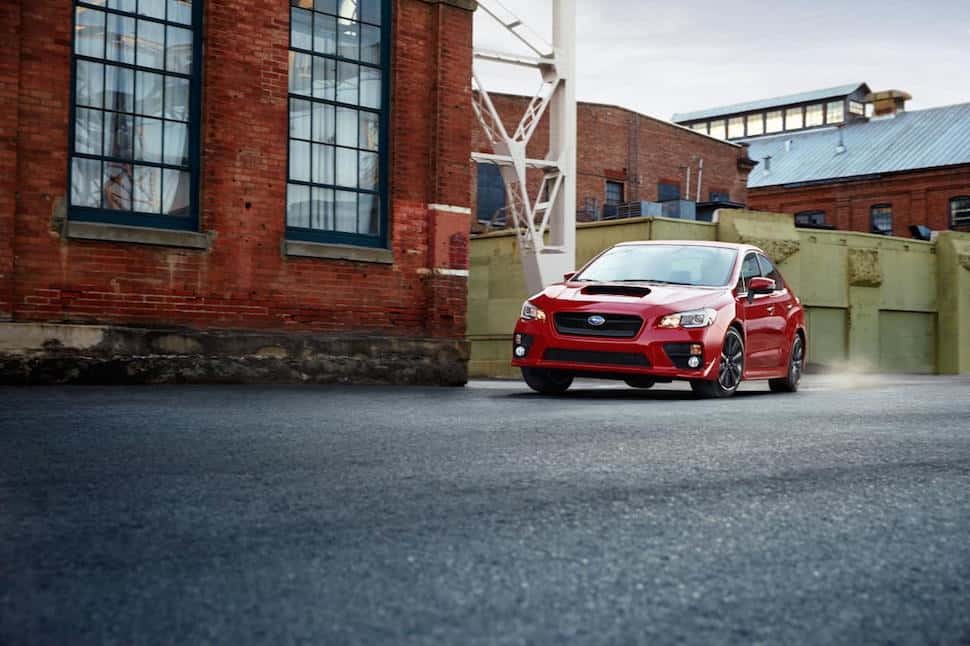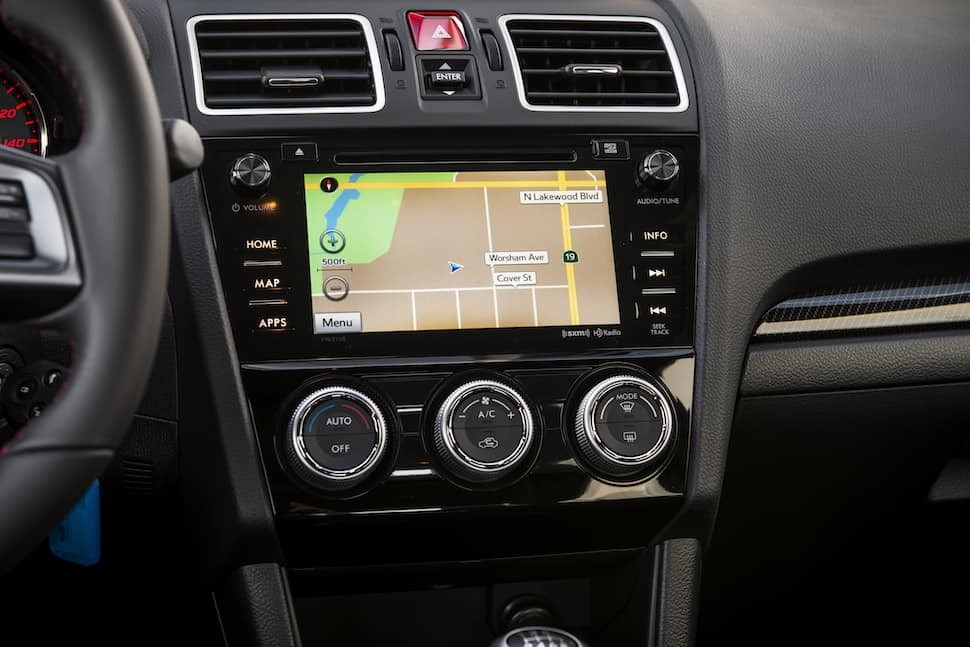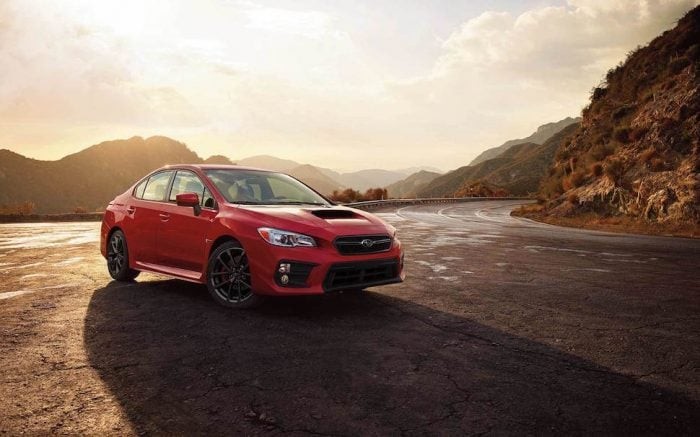The Subaru WRX has long been celebrated for its rally-bred performance and engaging driving dynamics. Rooted in the unassuming Impreza, the WRX transforms a practical compact car into a turbocharged thrill machine. While often associated with its iconic manual transmission, the Subaru WRX also offers a Continuously Variable Transmission (CVT) for those seeking automatic convenience without sacrificing the sporty spirit. But how does the automatic WRX stack up, especially when it comes to the crucial 0-60 mph sprint? Let’s delve into the performance, driving experience, and 0-60 time of the Subaru WRX automatic.
Under the Hood: The Heart of WRX Performance
2017 WRX. Photo: Subaru. Alt text: Front view of a blue 2017 Subaru WRX parked on a paved road, showcasing its sporty design.
The 2017 Subaru WRX is powered by a potent 2.0-liter turbocharged flat-4 engine, the core of its energetic personality. This engine delivers:
- Engine: 2.0L turbocharged flat-4
- Power Output: 268 horsepower
- Torque: 258 lb-ft
- Transmission: Optional Lineartronic CVT with manual mode and paddle shifters, or 6-speed manual transmission
- Drive Configuration: Symmetrical All-Wheel Drive (AWD)
While the original article focuses on the manual transmission’s character, it’s important to consider how the CVT option shapes the WRX’s performance and appeal. The turbocharger is key to the WRX’s enhanced power, nearly doubling the output compared to the base Impreza. This translates to a significant boost in driving excitement, making the WRX a far cry from your average commuter car.
Subaru WRX Automatic 0-60 MPH: Bridging Convenience and Speed
The original review mentions a 0-60 mph time of approximately 5.5 seconds for the manual transmission WRX. However, it omits the crucial figure for the automatic version. For drivers considering the CVT, the 0-60 mph time is a key performance indicator.
While official figures may slightly vary and Subaru doesn’t explicitly advertise the 2017 WRX CVT 0-60 time, independent testing and estimations place it in the range of 5.9 to 6.3 seconds. This is slightly slower than the manual, but still impressively quick for a sports sedan in its class and price range.
The slight difference in 0-60 times between the manual and automatic WRX is primarily due to the nature of the CVT transmission. CVTs prioritize smooth and efficient power delivery, sometimes at the expense of the immediate responsiveness of a traditional manual or automatic transmission. However, modern CVTs like Subaru’s Lineartronic have evolved significantly, offering simulated gear steps and manual modes to enhance driver engagement and performance feel.
The Automatic Advantage: Driving Dynamics and Daily Drivability
2017 WRX. Photo: Subaru. Alt text: Interior view of a 2017 Subaru WRX center console, highlighting the infotainment system and controls.
The choice between a manual and automatic transmission in the WRX boils down to driving preferences and priorities. While purists often favor the manual for its direct control and engagement, the automatic CVT offers distinct advantages:
- Ease of Use in Daily Driving: The CVT eliminates the need for constant clutch and gear work, making the WRX more comfortable in stop-and-go traffic and daily commutes.
- Smooth Power Delivery: The CVT provides seamless acceleration, keeping the engine in its optimal power band for efficient and consistent performance.
- Fuel Efficiency: In some driving conditions, the CVT can offer slightly better fuel economy compared to the manual transmission.
- Accessibility: The automatic option broadens the WRX’s appeal to a wider range of drivers who may not prefer or be able to drive a manual.
However, the original reviewer noted the manual WRX’s sensitive throttle and clutch, requiring practice for smooth launches. The CVT addresses this directly, offering smoother and more predictable acceleration from a standstill. The inclusion of paddle shifters and a manual mode in the CVT also allows drivers to engage more actively with the transmission when desired, simulating gear changes and providing a more dynamic driving experience.
Handling and Ride: Automatic vs. Manual WRX
The core handling characteristics of the WRX remain consistent regardless of the transmission choice. The sharp handling and tenacious grip in corners, attributed to Subaru’s Symmetrical All-Wheel Drive, are hallmarks of both manual and automatic versions. The body motion over uneven pavement, while noted as “a bit off-putting” in the original review, contributes to the WRX’s decent ride quality, making it more livable for daily use.
It’s unlikely that the transmission type significantly alters the WRX’s handling dynamics. The AWD system, suspension setup, and chassis contribute most significantly to its cornering prowess and overall driving feel. Whether equipped with a manual or automatic, the WRX remains a capable and engaging handler.
Interior and Practicality: Unchanged by Transmission
2017 WRX. Photo: Subaru. Alt text: Angled front view of a red 2017 Subaru WRX parked outdoors, emphasizing its sporty front fascia.
The practical interior of the WRX, stemming from its Impreza roots, is unaffected by the transmission choice. The supportive front seats, ample head and legroom, and useful 340-liter trunk remain the same in both manual and automatic models. These features enhance the WRX’s appeal as a performance car that doesn’t compromise on everyday usability.
The pricing and available features, such as the infotainment system, smartphone integration, and optional Sport-Tech package, are also consistent across transmission types. The CVT option itself adds a cost, but the core features and interior amenities remain the same, ensuring that both manual and automatic WRXs offer the same level of practicality and comfort.
Is the Automatic Subaru WRX Worth It? Balancing Performance and Convenience
The original review questions the overall “worth” of the 2017 WRX, highlighting its sometimes unrefined engine and aggressive character. However, for drivers specifically considering the automatic WRX, the question of “worth” takes on a slightly different dimension.
The automatic Subaru WRX, while slightly slower in 0-60 acceleration compared to the manual, offers a compelling blend of performance and convenience. It retains the WRX’s turbocharged power, sharp handling, and all-weather capability while adding the ease of use of an automatic transmission. For those who prioritize daily drivability, smooth commutes, or simply prefer an automatic, the CVT-equipped WRX is a very viable and enjoyable option.
The 5.9 to 6.3-second 0-60 mph time of the automatic WRX is still firmly in sports sedan territory, providing ample acceleration for merging onto highways, overtaking, and spirited driving. While it may not offer the raw, engaging feel of the manual, the automatic WRX delivers a refined and accessible performance experience that expands the WRX’s appeal to a broader audience.
2017 Subaru WRX Specs (Relevant to Automatic Transmission)
| Spec | Metric |
|---|---|
| Engine | 2.0L turbocharged flat-4 |
| Power Output | Approximately 268 horsepower |
| Torque | Around 258 lb-ft |
| Transmission | Lineartronic CVT with manual mode and paddle shifters (Optional) |
| Drive Configuration | Symmetrical All-Wheel Drive (AWD) |
| Acceleration (0-60 mph, Automatic) | Approximately 5.9 – 6.3 seconds (Estimated) |
| Top Speed | Electronically limited to around 155 mph (varies by model) |
| Fuel Economy | Varies based on transmission and driving conditions |



